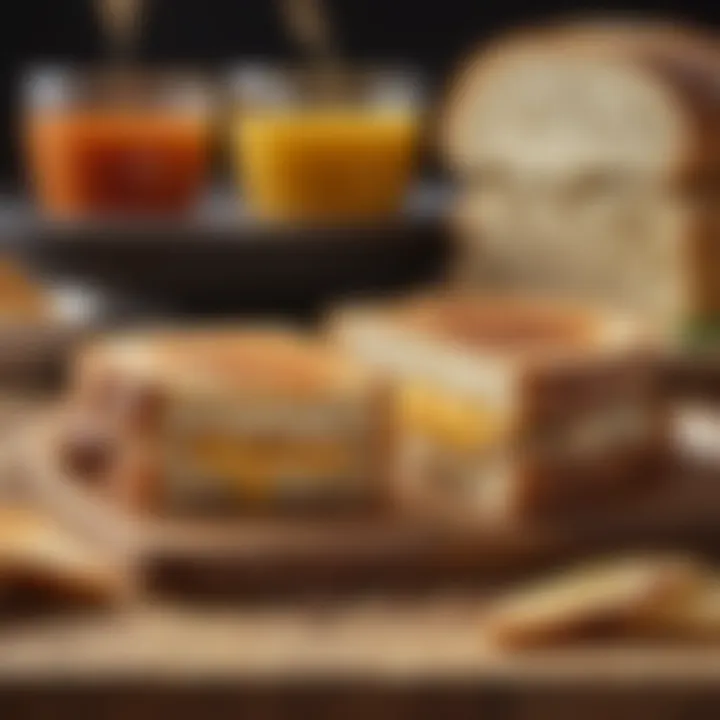The Perfect Cheese for Grilled Cheese Sandwiches


Intro
The quest for the perfect grilled cheese sandwich is both an art and a science. The type of cheese used plays a crucial role in the overall success of this timeless dish. This article will explore a myriad of cheese options, their unique characteristics, and how they contribute to the creamy, gooey delight that is the grilled cheese sandwich.
From sharp cheddars to creamy bries, the right cheese can elevate your sandwich from mundane to extraordinary. We will also discuss innovative combinations that enhance flavors and textures, accompany these with various bread choices, and consider dietary needs that might affect ingredient selection. This comprehensive guide is a resource for food lovers of all ages, aiming to enrich your grilled cheese experience.
Recipe Overview
Recipe name
The Ultimate Grilled Cheese Sandwich
Brief description of the dish
This beloved comfort food showcases gooey, melted cheese between slices of crispy, toasted bread. This guide will delve deeply into which cheese varieties are optimal for achieving that melt-in-your-mouth quality.
Ingredients List
Main ingredients
- Bread: Sourdough, whole grain, or white
- Cheese: Cheddar, Gruyere, and Fontina
Optional ingredients
- Butter or olive oil for sautéing
- Additions such as tomatoes, bacon, or pesto for added flavor
The choice of cheese can make or break your sandwich.
While some may prefer the classic sharp cheddar, others may be drawn to the depth of flavor offered by Gruyere. Understanding each option's melting characteristics and flavor profile is essential.
"The perfect grilled cheese hinges on the cheese's ability to melt, blend, and complement the bread and other ingredients. Choosing the right cheese varies the experience considerably."
This guide aims to bring forward all aspects of cheese varieties and their roles in enhancing this classic dish. The forthcoming sections will detail notable cheeses, their pros and cons, as well as insightful combinations to maximize flavor and enjoyment.
Understanding Grilled Cheese Fundamentals
Grilled cheese sandwiches are more than just a quick meal—they are a culinary staple across many cultures. Understanding the fundamentals of the grilled cheese process helps one appreciate the balance of flavor, texture, and technique involved in creating this beloved dish. The choice of cheese, the type of bread, and the cooking method all play roles in achieving perfection.
A Brief History of Grilled Cheese
The grilled cheese sandwich has its origins in the early 20th century, particularly during the Great Depression. It became a practical dish for families due to affordability and accessibility of its main components. Bread and cheese were inexpensive staples in many households. With the introduction of processed cheese, the grilled cheese adapted over time, evolving into the comforting meal we know today.
The versatility of this sandwich has allowed it to transcend generations, with variations popping up based on regional tastes and available ingredients. This rich history serves as a backdrop for understanding the modern interpretations of grilled cheese and encourages culinary creativity.
The Anatomy of a Grilled Cheese Sandwich
Understanding the anatomy of a grilled cheese sandwich is essential to appreciate what makes it so delicious.
Essential Ingredients
The essential ingredients of a grilled cheese sandwich are primarily bread and cheese. The choice of these components greatly impacts the final result. Bread acts as the vessel, contributing to the structural integrity and flavor profile. White bread, sourdough, or whole grain can all produce uniquely satisfying outcomes.
Cheese, of course, takes center stage. The melting quality and flavor of the cheese can transform the sandwich. For instance, aged cheddar provides a sharp taste, while American cheese lends a creamy texture. Generally speaking, cheeses that melt well, such as Gouda or Fontina, are favored for their ability to create a gooey inside.
Benefits of using high-quality bread and cheese are clear:
- Superior flavor enhances the overall experience.
- Better melting properties can aid in texture.
Common Variations
Common variations of grilled cheese sandwiches include adding ingredients such as tomatoes, bacon, or various herbs. These additions offer versatility and cater to diverse palates. The fascinating thing about these variations is that they allow for a personal touch—each sandwich can reflect individual preferences.
The key characteristic of these adaptations is that they maintain the grilled cheese's foundational elements while adding new flavors. Introducing items like pesto or roasted vegetables elevates the standard sandwich into something more complex and enticing. Though some may prefer the classic versions, exploring new twists can deepen one’s appreciation for this dish.
In summary, the fundamentals of grilled cheese examine its history, key ingredients, and variations, creating a foundation on which all further discussions about the best cheeses and techniques will be built. A broad understanding of these concepts enables both enthusiasts and newcomers to create exceptionally satisfying grilled cheese sandwiches.
Criteria for Selecting the Best Cheese
Selecting the right cheese is crucial for crafting the perfect grilled cheese sandwich. Cheese not only plays a major role in taste but also influences texture, meltability, and overall experience. Understanding these criteria helps in making informed choices when preparing this classic dish.
Meltability and Stretch
Meltability is a key aspect when it comes to cheese for grilled cheese sandwiches. The ability of a cheese to melt smoothly affects the texture of the sandwich. Cheeses that have high fat content, such as cheddar and gouda, typically melt well and provide that gooey mouthfeel that many crave. Stretch is another desirable characteristic; some cheeses, like mozzarella, can create long, stringy pulls, enhancing the visual appeal of the sandwich. Selecting cheeses with good meltability ensures that each bite delivers a satisfying experience, blending seamlessly with the bread and adding to the overall taste.
Flavor Compatibility


Flavor compatibility is essential for creating a balanced sandwich. Different cheeses bring unique profiles that can either complement or overpower other ingredients. For instance, a sharp cheddar can add a bold taste, while a mild mozzarella offers a creamier, subtler flavor.
Understanding Flavor Profiles
Understanding flavor profiles allows one to choose cheese that aligns with personal tastes. Each cheese has distinct characteristics, such as savory, sharp, or creamy notes that can impact the overall dish. Selecting cheese with well-matched profiles can elevate the sandwich. Stronger flavored cheeses, such as blue cheese, can provide boldness, while softer, mild cheeses add richness without overwhelming the palate. This understanding enables better pairings that meet the preferences of different eaters.
Pairing Cheese with Bread
Pairing cheese with bread is another critical consideration. The choice of bread can enhance or mute the flavors of the cheese. For example, a robust sourdough can stand up to a strong cheese like aged cheddar, while a soft white bread might be better suited for a delicate cheese like brie. Each combination can significantly alter the taste and texture experience, making it important to experiment with different pairings for optimal flavor harmony.
Texture Considerations
The texture of cheese contributes significantly to the mouthfeel of a grilled cheese sandwich. Creamy cheeses melt to form velvety layers, while firmer varieties might produce a crunchy texture when toasted. Choosing the right texture helps in creating contrast within the sandwich, leading to a well-rounded eating experience. A combination of textures can also be effective, such as pairing a melty cheese with a crisp bread crust, enhancing both the satisfaction and taste of the dish.
Top Cheese Choices for Grilled Cheese
The choice of cheese in a grilled cheese sandwich is a crucial aspect that defines its flavor and texture. The right cheese can provide a balance between creaminess, meltability, and taste that enhances the entire experience of consuming this classic dish. Understanding the available cheese options allows for a tailored approach to grilling, ensuring each sandwich is crafted to perfection.
Cheddar: The Classic Choice
Sharp vs. Mild Cheddar
Cheddar cheese is perhaps the most popular cheese for grilled cheese sandwiches. Varieties of cheddar, notably sharp and mild, contribute differently to the overall flavor profile. Sharp cheddar offers a robust and tangy flavor that complements the richness of butter used in the cooking process. Mild cheddar, on the other hand, provides a smoother, creamier taste and melts beautifully. The choice between sharp and mild often comes down to personal preference. Sharp cheddar can add a bite that contrasts nicely with softly toasted bread, while mild cheddar typically yields a more uniform creamy texture.
Pairings and Variations
Pairing cheddar with various breads and additional ingredients can elevate a simple grilled cheese. For instance, sourdough or whole-grain breads can enhance the nutty notes of sharp cheddar. Variations include adding ingredients like apple slices or crispy bacon, which offer sweet or salty complements that bring out the best in the cheese. This versatility makes cheddar a beneficial choice in creating various grilled cheese styles.
American Cheese: The Creamy Staple
The Appeal of Processed Cheese
American cheese often receives mixed reviews, yet it remains a beloved ingredient for grilled cheese. Its distinctive meltability is unparalleled, allowing it to create a delightfully gooey texture that many find satisfying. The smooth, creamy flavor works beautifully with simple toasted bread, making it a foundational cheese for many traditionalists. American cheese's consistent quality contributes greatly to its popularity in home kitchens and diners alike.
Combining with Other Cheeses
Combining American cheese with sharper varieties like cheddar can yield a well-rounded flavor. The creaminess of American cheese balances out the intensity of sharper cheeses, resulting in a layered taste experience. This combination opens avenues for experimentation, allowing chefs and home cooks to adjust the depth of flavor to their liking.
Gouda: The Smoky Alternative
Types of Gouda
Gouda, with its rich creaminess, offers a delightful alternative to traditional cheeses. There are several types of Gouda, including aged, smoked, and young varieties. Smoked Gouda introduces a unique flavor that can add complexity to a grilled cheese sandwich. Meanwhile, aged Gouda tends to be firmer with a more intense flavor profile that works well with robust breads like rye.
Flavor Combinations
Gouda’s versatility shines through when paired with ingredients such as caramelized onions or roasted peppers. These flavors work harmoniously, enhancing the richness of the cheese while providing a contrast of textures. This interplay makes Gouda a fantastic choice for those seeking a smoky and flavorful grilled cheese experience.
Fontina: The Gourmet Pick
Distinguishing Characteristics
Fontina cheese is known for its rich nuttiness and buttery flavor. It has a semi-soft texture that melts beautifully, adding a gourmet element to the classic grilled cheese. Its unique combination of flavors sets it apart and appeals to those looking for something beyond the usual choices.
Utilizing in Grilled Cheese
Using Fontina in grilled cheese can be transformative. Pairing it with artisanal bread and fresh herbs adds a touch of sophistication. This cheese pairs excellently with ingredients like sautéed mushrooms or truffle oil, making it a go-to for upscale grilled cheese recipes.
Mozzarella: Light and Stretchy
Fresh vs. Low-Moisture
Mozzarella is renowned for its stretchiness, often drawing admirers who appreciate that gooey feel. Using fresh mozzarella results in a milder flavor but creates an impressive visual when melted. Low-moisture mozzarella, however, tends to have a stronger flavor and a firmer texture. Choosing between these types can depend on the desired end result of the sandwich.
Best Bread Pairings
When it comes to bread, mozzarella shines best when grilled with a sturdy option like ciabatta or focaccia. These breads hold up well and provide a delightful crunch that complements the soft cheese. Pairing mozzarella with spinach or pesto can elevate the sandwich, offering a refreshing twist on the classic.
Brie: The Luxurious Option
Using Brie in Grilled Cheese
Brie cheese adds a layer of luxury to any grilled cheese creation. Its creamy and rich texture melts splendidly, providing a liqid component that feels indulgent. It can be used simply, or added to more elaborate sandwiches, allowing for countless culinary explorations.


Savory and Sweet Pairings
Brie pairs well with both savory and sweet ingredients. Incorporating figs, honey, or roasted garlic can create surprising flavor dynamics. This unique quality allows for creative experimentation, making Brie a sophisticated element in the grilled cheese realm.
Blue Cheese: A Bold Choice
Pairing with Other Cheeses
Blue cheese is bold, offering a strong, pungent flavor that can either enhance or dominate a sandwich. Pairing it with milder cheeses like mozzarella or gouda can create a balanced flavor profile. This blend allows the unique characteristics of blue cheese to be highlighted without overwhelming the dish.
Complementing Flavors
Foods like pear, walnuts, or arugula can complement blue cheese beautifully. These ingredients add fresh contrasts that enhance the richness of the cheese while providing delightful textures. This distinctive approach can appeal to adventurous eaters looking to expand their grilled cheese experience.
Innovative Cheese Combinations
The exploration of innovative cheese combinations is a crucial part of crafting the perfect grilled cheese sandwich. This section emphasizes the creativity that can be applied in choosing cheeses beyond traditional options. By mixing different types of cheese, one can achieve a more complex flavor profile and unique textures, enhancing the overall grilled cheese experience.
When considering innovative combinations, one can reflect on several elements. First, the interplay of flavors is vital. Different cheeses have distinct taste profiles; combining them can balance or contrast flavors, leading to surprising delights. Furthermore, textural contrast can elevate the sandwich. For instance, pairing a creamy cheese with a firmer one can create a delightful mouthfeel. Keeping these aspects in mind allows for a more adventurous and satisfying grilled cheese.
The Art of Mixing Cheeses
Mixing cheeses is an art form that can truly transform a simple grilled cheese into a culinary delight. The selection of cheese should depend on the desired taste and texture of the finished product. When combining cheeses, consider the flavor intensity; stronger flavors can often overpower milder ones. It is often adviseable to start with a base cheese and then complement it with others that will add depth and interest.
Unexpected Flavor Pairings
Incorporating unexpected flavor pairings can greatly enhance the grilled cheese sandwich. When pairing cheeses with other ingredients, there are no strict rules, and creativity plays a big role. Think outside the norm—combine savory with sweet, or introduce a tangy element to complement rich cheese. For example, blue cheese can be combined with sweet figs or apple slices, creating a delightful synergy.
Pairing Cheeses with Other Ingredients
Pairing cheeses with other ingredients can lead to delightful surprises. This aspect allows for limitless creativity, which is essential in exploring flavors. The key characteristic of this approach is the balance it introduces. Adding ingredients such as caramelized onions or spicy jalapeños can intensify the overall flavor. These additions add complexity and depth, essential for a memorable sandwich.
The unique feature here is the versatility of cheeses themselves. For example, aged cheeses bring a depth of flavor that contrasts pleasantly with fresh ingredients. On the other hand, fresh cheeses can neutralize overly strong flavors. To summarize, mixing and matching ingredients with cheese can elevate a grilled cheese from ordinary to extraordinary.
Regional Variations and Cultural Influences
The regional variations and cultural influences significantly shape cheese pairings, encouraging unique combinations. Each region boasts its own cheese-making traditions, which often influence how sandwiches are made and enjoyed. This characteristic is essential as it adds distinct flavors and techniques typical to a culture.
Exploring these variations lends an exciting aspect to grilled cheese. For instance, a traditional Italian combination might include mozzarella and ricotta, while a classic French mix could feature Comté and brie. This aspect enriches the culinary landscape, providing a plethora of options that represent the essence of different cultures.
The unique feature of embracing these influences is the ability to curate a grilled cheese experience that reflects personal tastes and cultural heritage. Each combination comes with its advantages—familiar flavors or innovative twists, empowering creators to experiment.
Dietary Considerations and Alternatives
Discussing dietary considerations and alternatives is vital in the context of grilled cheese sandwiches. Many people have specific dietary restrictions or preferences due to health concerns, ethical choices, or lifestyle factors. Paying attention to these aspects allows cheese lovers to enjoy this classic dish without sacrificing taste or satisfaction. Within this section, we will explore lactose-free options and vegan cheese alternatives, ensuring that everyone can experience the joy of a comforting grilled cheese sandwich regardless of their dietary needs.
Lactose-Free Options
Lactose intolerance affects many individuals, making it difficult for them to enjoy dairy products. Lactose-free cheese is a practical solution. It is made by adding lactase enzymes to break down lactose, allowing lactose-intolerant individuals to consume dairy without discomfort.
There are several types of lactose-free cheeses available:
- Lactose-Free Cheddar: A favorite for grilled cheese. It has a strong flavor and melts well, mimicking regular cheddar.
- Lactose-Free Mozzarella: Often used for a lighter grilled cheese. It offers stretchiness and a mild taste that pairs well with various breads.
- Lactose-Free American Cheese: Very popular for its creaminess and melting qualities. A great choice for that classic grilled cheese feel.
These options allow those who are lactose intolerant to enjoy a delightful sandwich without worry. It is essential to read labels and ensure that the chosen product is genuinely lactose-free.
Vegan Cheese Alternatives
Vegan cheese has gained popularity in recent years, catering to those who follow a plant-based diet. Made from various non-dairy ingredients like nuts, soy, or coconut, vegan cheese can offer a satisfying substitute for traditional cheese.
Several types of vegan cheese are suitable for grilled cheese:
- Cashew Cheese: Often has a creamy texture and rich flavor. It can melt when heated, providing a pleasing sandwich experience.
- Soy-Based Cheese: Made from soy milk, this option typically melts well and has a texture similar to American cheese. It works well in a classic grilled cheese setting.
- Coconut-Based Cheese: Often made with added starches that help it melt. The slight sweetness of coconut can create a unique flavor profile.
Vegan cheese may not melt in the same way dairy cheeses do, so it may require some experimentation to achieve the desired consistency.
When selecting vegan cheese, look for brands that offer a variety of textures and flavors to enhance your grilled cheese experience.
In summary, understanding dietary considerations and alternatives enhances the grilled cheese sandwich experience for everyone. By offering lactose-free options and vegan cheese alternatives, we ensure that this beloved comfort food is accessible to a broader audience.
Techniques for the Perfect Grilled Cheese
The right technique can make or break your grilled cheese experience. This section will focus on various methods that contribute to achieving the ideal grilled cheese sandwich, encompassing bread selection, cooking methods, and additional flavoring techniques. Each element can enhance the taste, texture, and overall satisfaction of this classic dish.


Bread Selection
Choosing the appropriate bread is crucial in developing that flavorful, crispy exterior while maintaining a melty interior.
Best Types of Bread
When it comes to selecting the bread for grilled cheese, options such as sourdough, whole grain, and white bread often stand out. Sourdough, for instance, offers a slightly tangy flavor, which complements a variety of cheeses beautifully. Whole grain provides a nuttier taste, while white bread contributes to a fluffy texture.
A key characteristic of these breads is their ability to hold up during grilling. Sourdough, with its chewy crust, protects the soft cheese inside, whereas white bread tends to brown evenly, creating a pleasant crunch.
However, one should consider the disadvantages, such as the size of the slices. If too thick, you might end up with an undercooked interior. Thus, the balance in thickness is paramount to achieving a harmonious sandwich.
Gluten-Free Alternatives
For those with dietary restrictions, gluten-free bread options are essential. Many brands offer gluten-free varieties made from rice flour, almond flour, or even chickpea flour. These options are increasingly popular among those seeking to enjoy grilled cheese without gluten.
A major advantage of gluten-free bread is its accessibility. It allows many to partake in this beloved dish without compromising their dietary needs. However, some gluten-free breads can lack the structural integrity of traditional options, leading to a less satisfying grip on the cheese.
Cooking Methods
The method you choose to cook your grilled cheese drastically impacts the final outcome. Choices like stovetop and oven cooking can yield different results and should be considered carefully.
Stovetop vs. Oven
Cooking grilled cheese on the stovetop is the traditional method, allowing for direct heat and the possibility to monitor the browning closely. This method is quick and can create that golden crust while melting the cheese nicely.
On the other hand, using an oven gives an altogether different advantage. It minimizes the chance of burning while ensuring an even melt throughout the sandwich. However, it typically requires longer cooking times, which can be a disadvantage if one is seeking a quick meal.
Grilled vs. Pressed
The choice between grilled and pressed further adds variety to the preparation of grilled cheese. Grilled sandwiches are often more rustic, with a crispy exterior. Pressed sandwiches, conversely, offer an even cooked surface, and the pressure helps with cheese melt and amalgamation of flavors.
Each method has its merits. Pressed sandwiches can create a uniform taste but may lack some of the charm of a hand-grilled version that varies in texture.
Additional Flavoring Techniques
Enhancing a grilled cheese sandwich goes beyond simply selecting the best ingredients. Incorporating spices, herbs, and other accoutrements can elevate a conventional sandwich to something memorable.
Spices and Herbs
Spices and herbs are often overlooked but play an essential role in flavor development. Simply adding crushed garlic, basil, or even a hint of chili flakes to the butter can infuse the bread with a new depth of flavor.
The use of spices and herbs is advantageous; they can easily be adjusted to match personal preferences. However, too much seasoning can overwhelm the classic cheese flavor, thus requiring a careful balance.
Experimenting with Accoutrements
In addition to spices, experimenting with various accoutrements can transform your grilled cheese. Ingredients like roasted tomatoes, avocados, or even bacon can add textural contrast and robust flavors.
These extras allow for creativity, and each addition can bring about new dimensions to the dish. However, it's crucial to ensure that the sandwich remains cohesive. Overloading the sandwich can lead to an unwieldy creation that falls apart.
"Grilled cheese is not just a sandwich; it’s a canvas for culinary creativity."
By understanding and applying these techniques, one can achieve the perfect grilled cheese. Whether you stick to the classics or explore innovative methods, the process is as enjoyable as the end product.
Finale
The conclusion serves to cement the key elements discussed in this article, bringing together the various aspects of selecting the perfect cheese for grilled cheese sandwiches. Understanding the foundations of grilled cheese, the selection criteria for cheeses, and the various methods of preparation is essential for anyone aiming to perfect their grilled cheese experience.
In the prior sections, we explored the unique traits of diverse cheeses, such as sharp cheddar, creamy American, and rich Brie. Each cheese carries its own melting properties and flavor profiles. The significance of balancing these attributes cannot be overstated. Cheese not only enhances the taste but also impacts the texture and overall sensory experience of the dish. Choosing the appropriate cheese contributes to achieving the ideal melt, flavor compatibility, and even visual appeal.
Moreover, we highlighted innovative cheese combinations and alternative options that cater to various dietary needs. The importance of accommodating preferences, whether lactose-free or plant-based, ensures that grilled cheese remains accessible to a wide range of food lovers.
"The grilled cheese sandwich is not merely a comfort food; it transforms into a culinary expression when crafted with care in cheese selection and preparation techniques."
This article encourages readers to embrace the versatility of grilled cheese, analyzing each ingredient thoughtfully. Adhering to the main criteria—meltability, flavor, and texture—ensures that any creation will leave a lasting impression.
Ultimately, the exploration of grilled cheese sandwiches is not just about taste but also about creativity in the kitchen. Whether you prefer traditional combinations or unique blends, careful consideration of the cheese is the first step in making a truly exceptional sandwich.
Recap of Key Points
- Meltability of Cheese: Essential for a satisfying texture.
- Flavor Profiles: Understanding different profiles helps pair cheese with bread and additional flavors effectively.
- Texture Variability: Each cheese contributes uniquely. Some are creamy, while others are firm.
- Dietary Options: Catering to various preferences increases the audience for this classic dish.
- Cooking Techniques: Stovetop, oven, and other methods differ in outcome.
Encouragement to Experiment
Food is not a static endeavor. It is about innovation and playfulness. Therefore, experimenting with different combinations of cheese, bread, and additional ingredients can lead to exciting discoveries.
The core takeaway is to not be limited by conventional pairings. Instead, allow your taste preferences to guide you. Try mixing Gouda with blue cheese or incorporating unexpected elements like spicy peppers or sweet jams. The combinations are nearly endless.
Engagement with the process will reveal personal preferences and maybe even spark new trends among friends and family. As we refine our understanding of grilled cheese sandwiches, we also evolve our culinary skills. So, grab your skillet and your favorite cheese, and start experimenting. The ultimate grilled cheese is out there, waiting for your personal touch.







